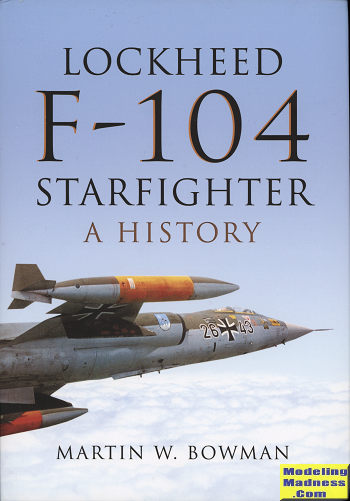 The missile
with a man in it. That was how Lockheed described its then new F-104. It
certainly looked the part with its sleek fuselage that came to a point, its
seemingly tiny wings and its tall horizontal stabilizer. Indeed, the purpose
behind the F-104 was to put the biggest available engine into the smallest
airframe possible. The Starfighter was designed to be an interceptor and not a
dog-fighter. This meant it had to be fast and fast it was. However, like most
interceptors of the time, it was fairly short ranged even with additional wing
tip fuel tanks. But those tanks meant there was no room for the missiles.
The missile
with a man in it. That was how Lockheed described its then new F-104. It
certainly looked the part with its sleek fuselage that came to a point, its
seemingly tiny wings and its tall horizontal stabilizer. Indeed, the purpose
behind the F-104 was to put the biggest available engine into the smallest
airframe possible. The Starfighter was designed to be an interceptor and not a
dog-fighter. This meant it had to be fast and fast it was. However, like most
interceptors of the time, it was fairly short ranged even with additional wing
tip fuel tanks. But those tanks meant there was no room for the missiles.
As you can guess, the aircraft was modified to take care
of some of its short comings. Such as the downward firing ejection seat (who
thought that one up?). As the type was entering service, the USAF realized it
really did not need this plane so not all that many were built for the USAF.
They were sent to war in Vietnam where it was thought an interceptor would be a
good idea, but these planes basically performed ground attack missions.
Where the F-104 really made inroads was with foreign
sales. Additional modifications made it into a passable fighter-bomber. It was
also license built in Italy, Japan and with a European consortium. For most NATO
air forces the type was a lot more than they expected. Transitioning from a
'country club' air force with F-84s and F-86s to the F-104 resulted in a fairly
large number of crashes and deaths. The 104 was a plane where the pilot had to
pay attention 100% of the time while flying it. Distractions could be deadly and
were. Eventually proper training eliminated the large number of deaths, but the
plane still crashed with some regularity. Canada, for instance, lost over half
its fleet during the operational life of the plane and some other nations were
close, while yet others had no issues at all.
In the US, the type was quickly removed from USAF
service and handed over to the ANG where some units flew it for decades. It was
also modified to drones and was used fairly extensively by NASA, which had three
planes especially built for it.
In this book, the author presents the full story of the
aircraft. There are a fairly large number of pilot stories, which help to
illustrate the issues of operating what was a fairly advanced aircraft. The book
is also jammed full of photos, some of them two pages in size so you'll have to
deal with the 'ditch' in these cases. The author also injects information into
many of the photos by providing the fate of the aircraft shown.
It is a book that is highly readable and the anecdotes
add to the interest of the title. You will be very pleased with this one and it
is one I can highly recommend to you.
November 2019
Copyright ModelingMadness.com. All rights reserved.
Review book courtesy of
Casemate Publishing, where you can order your copy
at this link.
If you would like your product reviewed fairly and
fairly quickly, please
contact
me or see other details in the
Note to
Contributors.
 The missile
with a man in it. That was how Lockheed described its then new F-104. It
certainly looked the part with its sleek fuselage that came to a point, its
seemingly tiny wings and its tall horizontal stabilizer. Indeed, the purpose
behind the F-104 was to put the biggest available engine into the smallest
airframe possible. The Starfighter was designed to be an interceptor and not a
dog-fighter. This meant it had to be fast and fast it was. However, like most
interceptors of the time, it was fairly short ranged even with additional wing
tip fuel tanks. But those tanks meant there was no room for the missiles.
The missile
with a man in it. That was how Lockheed described its then new F-104. It
certainly looked the part with its sleek fuselage that came to a point, its
seemingly tiny wings and its tall horizontal stabilizer. Indeed, the purpose
behind the F-104 was to put the biggest available engine into the smallest
airframe possible. The Starfighter was designed to be an interceptor and not a
dog-fighter. This meant it had to be fast and fast it was. However, like most
interceptors of the time, it was fairly short ranged even with additional wing
tip fuel tanks. But those tanks meant there was no room for the missiles.